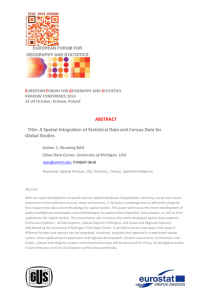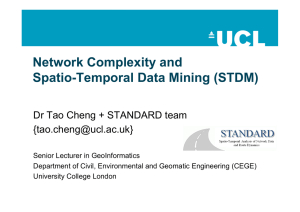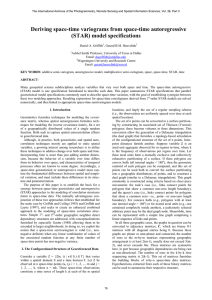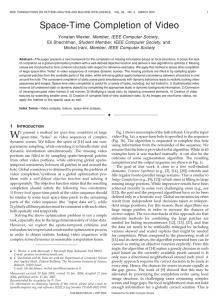Document 11863904
advertisement
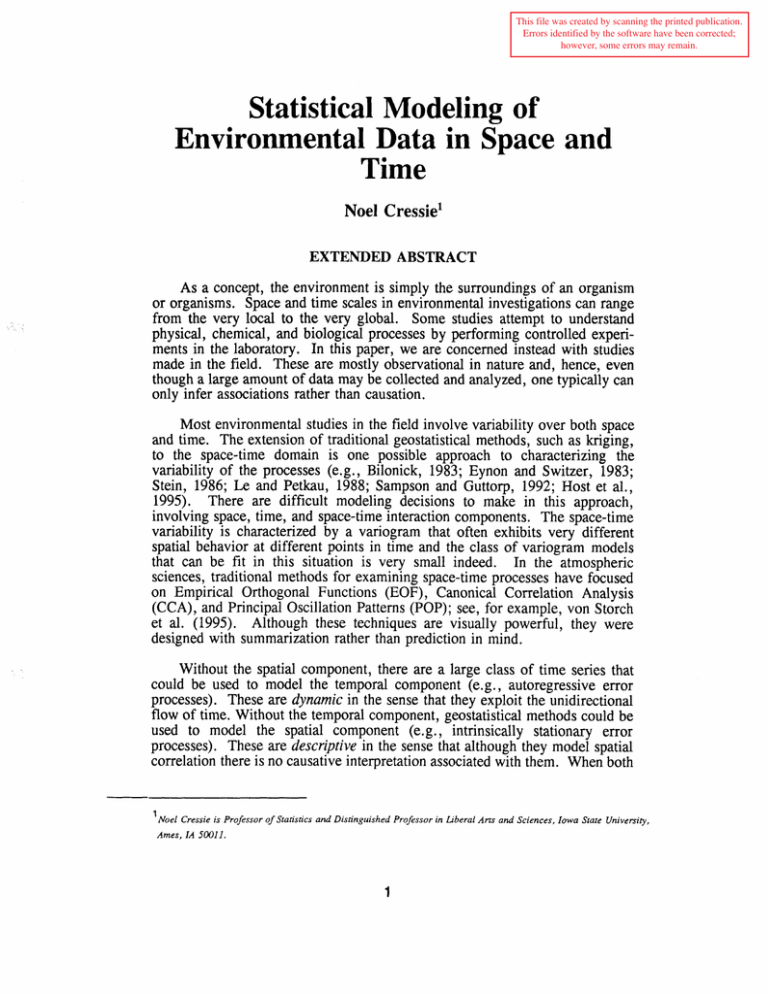
This file was created by scanning the printed publication.
Errors identified by the software have been corrected;
however, some errors may remain.
Statistical Modeling of
Environmental Data in Space and
Time
Noel Cressiel
EXTENDED ABSTRACT
As a concept, the environment is simply the surroundings of an organism
or organisms. Space and time scales in environmental investigations can range
from the very local to the very global. Some studies attempt to understand
physical, chemical, and biological processes by performing controlled experiments in the laboratory. In this paper, we are concerned instead with studies
made in the field. These are mostly observational in nature and, hence, even
though a large amount of data may be collected and analyzed, one typically can
only infer associations rather than causation.
Most environmental studies in the field involve variability over both space
and time. The extension of traditional geostatistical methods, such as kriging,
to the space-time domain is one possible approach to characterizing the
variability of the processes (e.g., Bilonick, 1983; Eynon and Switzer, 1983;
Stein, 1986; Le and Petkau, 1988; Sampson and Guttorp, 1992; Host et al.,
1995). There are difficult modeling decisions to make in this approach,
involving space, time, and space-time interaction components. The space-time
variability is characterized by a variogram that often exhibits very different
spatial behavior at different points in time and the class of variogram models
that can be fit in this situation is very small indeed. In the atmospheric
sciences, traditional methods for examining space-time processes have focused
on Empirical Orthogonal Functions (EOF), Canonical Correlation Analysis
(CCA), and Principal Oscillation Patterns (POP); see, for example, von Storch
et al. (1995). Although these techniques are visually powerful, they were
designed with summarization rather than prediction in mind.
Without the spatial component, there are a large class of time series that
could be used to model the temporal component (e.g., autoregressive error
processes). These are dynamic in the sense that they exploit the unidirectional
flow of time. Without the temporal component, geostatistical methods could be
used to model the spatial component (e.g., intrinsically stationary error
processes). These are descriptive in the sense that although they model spatial
correlation there is no causative interpretation associated with them. When both
' ~ o e Cressie
l
is Professor of Szatistics and Distinguished Professor in Liberal A N and Sciences, Iowa Stare Uniwrsizy,
Ames, IA 50011 .
temporal and spatial components are present, it seems sensible to use models
that are a combination of both approaches, namely temporally dynamic and
spatially descriptive. That is the new feature of our work and it allows a natural
development of the space-time Kalman filter.
To give some definiteness to the problem, consider Markov temporal
models with spatial colored noise:
where St(s) is an (unobserved) value of the state process at location s and time
t. The observations are actually
which expresses the data as a noisy version of the state process. The goal is to
predict St (so), where both t, and so may or may not represent space-time
0
coordinates at which data are available. In (I), (a,,. ..,ap) are autoregressive
parameters (i.e., parameters of the "temporally dynamic" component) and, most
importantly, qt(*) is a spatially-colored noise process (i.e., the "spatially
descriptive" component). In (2), E,(*)is a white-noise process representing
measurement error.
Data come in the form,
where it is not essential that all observations are available at each time point and
at each spatial location. The optimal predictor of St (so) is:
0
with mean-squared prediction error,
Both these quantities can be calculated recursively, using what could be called
a space-time Kalman filter (Huang and Cressie, 1996).
The state-space model in (1) is very attractive because it features the
dynamic aspect through an autoregressive structure but builds in space-time
interaction through the error process q,, which is, at any point in time, a
spatially correlated (e.g., intrinsically stationary) process. Notice that St(s) is
influenced directly by past values only at location s. In reality, spatio-temporal
processes are likely to be more complicated, to have dependence also on past
values at locations u near s. Thus, I shall investigate the spatio-temporal
climate model,
where, for identifiability, the coefficients o,(u) satisfy 1 w,(u)du = 1.
Development of the spatio-temporal Kalman Filter allows prediction of St (so)
0
based on data Z, ,...,Z,.
The two challenging aspects of this research are to derive the expressions
for the optimal predictor and the optimal mean-squared prediction error, and to
obtain efficient estimators of the parameters a , var(e,(s)), and cov(qt(s),qt(u)).
These are then substituted into the optimal prediction equations. (This research
is in progress with Ph.D. student Christopher K. Wikle.) An alternative to the
estimation of parameters is to put (prior) distributions on them. In this case,
there is a good physical reason to do this. The parameters almost certainly vary
from year to year and from region to region; this extra variation can quite
simply be handled by replacing a in (3) with {a,,. ..,a,,,a,,. ..} and assuming
them to be distributed according to some prior distribution. The goal is still to
obtain E(St (so) 1 Zl ,...,253 and its mean-squared prediction error or, more
0
generally, the posterior distribution of St0(so) given Z,, ...,25,. While such
calculations were daunting five years ago, Markov chain Monte Carlo (e.g.,
Bemardo and Smith, 1994, Section 5.5.5) can be invoked to handle the
problem.
REFERENCES
Bemardo, J.M. and Smith, A.F.M. (1994). Bayesian Theory. Wiley,
Chichester.
Bilonick, R.A. (1983). Risk qualified maps of hydrogen ion concentration for
the New York state area for 1966-1978. Atmospheric Environment, 17,
25 13-2524.
Eynon, B.P. and Switzer, P. (1983). The variabiity of rainfall acidity.
Canadian Journal of Statistics, 11, 11-24.
Host, G., Omre, H., and Switzer, P. (1995). Spatial interpolation errors for
monitoring data. Journal of the American StatisticalAssociation, 90, 853861.
Huang, H. C. and Cressie, N. (1996). Spatio-temporal prediction of snow water
equivalent using the Kalman filter. Computational Statistics and Data
Analysis, in press.
Le, D.N. and Petkau, A.J. (1988). The variability of rainfall acidity revisited.
Canadian Journal of Statistics, 16, 15-38.
Sampson, P.D. and Guttorp, P. (1992). Nonparametric estimation of
nonstationary spatial covariance structure. Journal of the American
Statistical Association, 87, 108-119.
Stein, M. L. (1986). A simple model for spatial temporal processes. Water
Resources Research, 22, 2 107-2110.
von Storch, H., Burger, G . , Schnur, R., and von Storch, J.S. (1995). Principal
oscillation patterns: A review. Journal of Climate, 8, 377-400.




